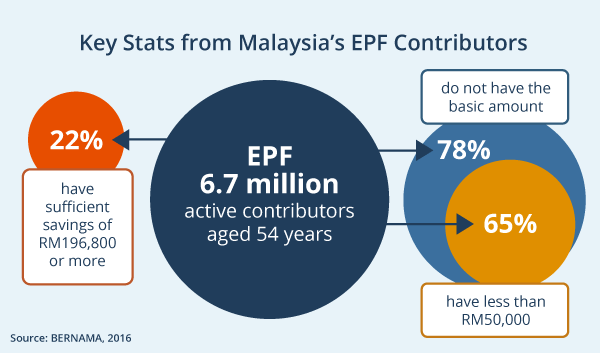
Effective 1 January 2017, the Employees Provident Fund (EPF) has revised the quantum for basic savings from RM196,800 to RM228,000. The amount will be set as the minimum target for EPF savings when members turn 55 years old.
EPF revised the amount in light of the rising cost of living, longer life expectancy and a higher inflation rate. The new quantum is benchmarked against the minimum pension for public sector staff, which has been raised from RM820 to RM950 per month for 20 years upon reaching the age of 55.
However the new quantum only refers to the basic savings considered sufficient to support a member’s basic retirement needs.
Is the new quantum enough to sustain you through retirement?
EPF provides wider pension coverage than countries such as Indonesia and India; in terms of pension contribution rates, Malaysia is the world’s fifth highest. Despite this, Malaysians are still likely to exhaust their entire EPF savings five years after the first withdrawal.
On paper, the new quantum of RM950 per month looks sufficient. But this is only true if every single sen is spent on basic needs.
The harsh reality is that Malaysians spend 31.2% of their disposable income on food and food away from home, 23.9% on petrol, housing and utilities, and 14.6% on transport. Life after retirement is expensive! After taking all these lifestyle factors into consideration, RM950 might actually not be enough! What can you do about it?
Enter, EPF-approved unit trusts
One way to boost your chances of retirement survival is to grow your EPF contributions at a quicker rate. Did you know that EPF contributors can invest a portion of their savings into unit trust funds?
The scheme provides members with an option to enhance their retirement savings by placing a portion of their EPF savings in Account 1 to be invested in unit trusts or through private mandate managed by appointed Fund Managers Institutions (FMI) under the EPF Members Investment Scheme (EPF-MIS). However, contributors will need to have higher savings in their EPF accounts to participate in the EPF-MIS.
These funds need to achieve a three-year simple average consistent return rating of 2.00, sourced from mutual and hedge fund analytics provider Lipper, which has a scale of 1 to 5.
To invest or not to invest – that is the question
In February 2016, EPF announced a 6.40% dividend rate for 2015, with a total payout of RM38.24 billion. It was 0.35 percentage points less than in 2014, which was at 6.75%.
Whether the dividend was satisfactory depends on a few factors but in today’s volatile market, only a handful of funds can match the performance shown by EPF, given that it’s a capital guaranteed fund. Additionally, the guaranteed minimum rate of 2.5% makes EPF a secure long-term investment, especially for retirement savings.
There are a few ways to calculate dividends but the pressing question is: should one just rely on EPF dividends or make a portion of the savings “work harder” through unit trust funds?
Well, a simple comparison was done between the EPF dividend and top performing EPF-approved fund Kenanga Growth Fund. It was found that Kenanga, based on the conservative historical annualised dividend rate of 8.00% still outperformed the historical dividend rates of EPF.
Of course, leaving your money in your EPF account is certainly less risky, but you may risk not building enough of a nest egg to fund your golden years. Therefore, withdrawing a sum from your EPF savings to invest in a unit trust fund is indeed a good way to boost your retirement savings.
The rule of thumb for investing is to start as early as possible, and this also applies to EPF-approved unit trust funds. Unit trust investments are known for their long-term value; usually up to five years or longer.
For EPF members, they have the added advantage of being able to familiarise themselves with the track record of appointed fund managers before making their decisions.
Perhaps the first step you can take is to monitor your EPF contributions and growth. Obtaining the latest statement can be done online through i-Akaun at myEPF website.
Alternatively, members can obtain their statement via EPF kiosks or visit any EPF branches. So, are you going to boost your retirement funds by shifting some of your EPF money into approved unit trust funds? The answer starts with you!



No comments:
Post a Comment